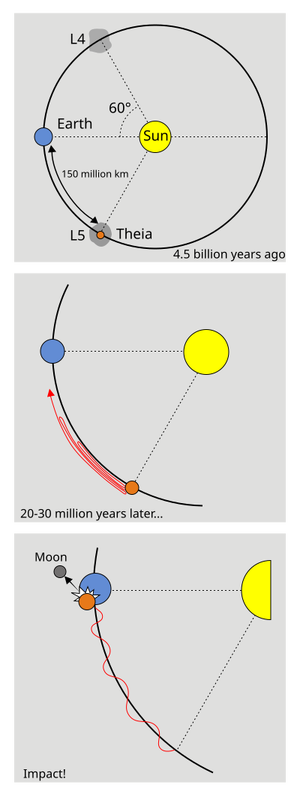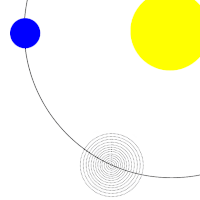
The Big Splash. View from the south pole.
The giant impact hypothesis (sometimes referred to as the big whack, or less frequently, the big splash) is the now-dominant scientific theory for the formation of the Moon, which is thought to have formed as a result of a collision between the young Earth and a Mars-sized body that is sometimes called Theia or occasionally Orpheus. The name of Theia /'theI.a/ is derived from Greek mythology, as Theia was the Titan who gave birth to the Moon goddess Selene. The hypothesis - not to be confused with that of the "Big Bang", or celestial based theories of Dinosaur extinction - was first proposed in a paper published in Icarus in 1975 by Drs. William K. Hartmann and Donald R. Davis.
Origins[]
One hypothesis posits that Theia formed at a Lagrangian point relative to Earth, that is, in about the same orbit and about 60° ahead or behind.[1] When the protoplanet Theia had grown to about the size of Mars, its size made it too heavy for its status (comparable to the Trojan asteroids in the orbit of Jupiter) to be stable. As a result, its angular distance from Earth varied more and more until it finally hit the Earth.
According to this hypothesis, 4.533 billion years ago (4.533 Ga) - that is, just 34 million years after Earth formed - Theia hit the Earth at an oblique angle, destroying Theia, and ejecting most of Theia's mantle and a significant portion of the Earth's silicate mantle into space. Current estimates based on computer simulations of such an event suggest that some two percent of the original mass of Theia ended up as an orbiting ring of debris, and about half coalesced into the Moon between one and 100 years after the impact. Whatever original rotation and inclination the proto-Earth had before the impact, after the impact it would have had a day of circa five hours in length, and the Earth's equator would have been now closer to the plane of the Moon's orbit.
Geological evidence[]
Indirect evidence for this impact scenario comes from rocks collected during the Apollo Moon landings, which show oxygen isotope compositions that are nearly the same as the Earth. The highly anorthositic composition of the lunar crust, as well as the existence of KREEP-rich samples, gave rise to the idea that a large portion of the Moon was once molten, and a giant impact scenario could easily have supplied the energy required to form such a magma ocean. Several lines of evidence indicate that if the Moon possesses an iron-rich core, that it must be small. In particular, the mean density, moment of inertia, rotational signature, and magnetic induction response all suggest that the core is less than about 25% the radius of the Moon, in comparison to about 50% for most of the other terrestrial bodies. Impact conditions can be found that give rise to a Moon that formed mostly from the mantles of the Earth and impactor, with the core of the impactor accreting to the Earth, and which satisfy the angular momentum constraints of the Earth-Moon system.[2]

Animation of Theia forming in Earth's L5 point and then drifting into impact. The animation progresses in one-year steps (prior to impact) making Earth appear not to move. The view is of the south pole.
Difficulties[]
Even the dominant lunar origin theory has some difficulties which have yet to be explained. These difficulties include:
- Some of the Moon's volatile elements are not depleted as expected from the giant impact hypothesis.[3]
- There is no evidence that the Earth ever had a magma ocean (an implied result of the giant impact hypothesis)[3]
- Iron oxide (FeO) content of 13% of the bulk Moon properties rule out the derivation of the proto-lunar material from any but a small fraction of Earth's mantle.[4]
- If the bulk of the proto-lunar material had come from the impactor, the Moon should be enriched in siderophilic elements, when it is actually deficient of those.[5]
- Formation of the Moon requires about twice the amount of angular momentum that the Earth-Moon system has now.[citation needed]
- The Earth's crust is made of two layers called sima and sial. Sima is the lower and denser layer. It is 5 to 10 km thick and covers the entire surface of the Earth. Sial is 20-70 km thick and covers only 30% of the Earth's surface; this is the elevated part of the Earth's surface called continents. The remaining 70% of the Earth's surface is covered with oceans. None of the existing theories explain how the sial was selectively scooped up from 70% of the Earth's surface and deposited on the Theia/proto-Moon.
See also[]
- Moon
- Geology of the Moon
- KREEP
- Roche radius
References[]
Cited references
- ↑ E. Belbruno and J. Richard Gott III, The Astronomical Journal, Volume 129, Issue 3, pp. 1724-1745 (2005) preprint
- ↑ R. Canup and E. Asphaug (2001). "Origin of the Moon in a giant impact near the end of the Earth's formation". Nature 412: 708-712.
- ↑ 3.0 3.1 Tests of the Giant Impact Hypothesis, J. H. Jones, Lunar and Planetary Science, Origin of the Earth and Moon Conference, 1998 [1]
- ↑ The Bulk Composition of the Moon, Stuart R. Taylor, Lunar and Planetary Science, 1997, [2]
- ↑ E. M. Galimov and A. M. Krivtsov (December 2005). "Origin of the Earth-Moon System". J. Earth Syst. Sci. 114 (6): 593-600. [3]
Scientific references
- William K. Hartmann and Donald R. Davis, Satellite-sized planetesimals and lunar origin, (International Astronomical Union, Colloquium on Planetary Satellites, Cornell University, Ithaca, N.Y., Aug. 18-21, 1974) Icarus, vol. 24, Apr. 1975, p. 504-515
- Alastair G. W. Cameron and William R. Ward, The Origin of the Moon, Abstracts of the Lunar and Planetary Science Conference, volume 7, page 120, 1976
- Canup, R. M.; Asphaug, E. (Fall Meeting 2001). "An impact origin of the Earth-Moon system". Abstract #U51A-02, American Geophysical Union. Retrieved on 2007-03-10.
- R. Canup and K. Righter, editors (2000). Origin of the Earth and Moon. University of Arizona Press, Tucson, 555 pp.
- Charles Shearer and 15 coauthors (2006). "Thermal and magmatic evolution of the Moon". Reviews in Mineralogy and Geochemistry 60: 365-518.
General references
- Dana Mackenzie, The Big Splat, or How Our Moon Came to Be, 2003, John Wiley & Sons, ISBN 0-471-15057-6.
- G. Jeffrey Taylor (December 31, 1998). Origin of the Earth and Moon.
External links[]
- Planetary Science Institute: Giant Impact Hypothesis
- Computer modelling of the Moon's creation (Space.com)
- Origin of the Moon by Prof. AGW Cameron
- Klemperer Rosette simulations using Java applets
- SwRI giant impact hypothesis simulation (.wmv and .mov)
- How Did The Moon Get Into Orbit?
- Origin of the Moon - computer model of accretion
Template:Moon footer